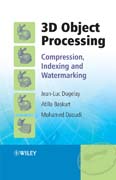
Written by a team of experienced practitioners, 3D Object Processing providesa systematic and comprehensive overview of 3D object processing from a multimedia point of view. Rich with practical open questions, case studies, and information on perspectives and challenges, the text explores several different types of 3D data sources, such as 3D data from acquisition systems, CAD (computer-aided design) triangulated 3D meshes, and 3D cloud of points with regular orirregular sampling. Graduate students, researchers, and practicing engineers will find this guide to be an essential tool. INDICE: About the contributors. Introduction . 1.1 Introduction. 1.1.1 Diverse domains using and manipulating 3-D objects. 1.1.2 Introduction to 3D dataexchange. 1.2 Representation. 1.2.1 Notion of 3-D Objects and diverse digitalrepresentations of. 3-D object. 1.2.2 A rapid survey of main 3D object representation: Meshes,. NURBS, CSG. 1.3 Basic notions in 3-D. 1.4 Acquisition, Database and editing. 1.5 About this book. Basic background in 3D Object Processing . 1.1 3D representation and models. 1.1.1 Basics notions of 3D Object representation. 1.1.2 Polygonal meshes. 1.1.3 Surface based models. 1.1.4 Volumetricrepresentation. 1.2 3D data source. 1.2.1 acquisition. 1.2.2 Manual creation.1.2.3 3D object databases. 1.3 3D Quality concepts. 1.3.1 Existing 2D perceptual metrics. 1.3.2 Existing 3D perceptual metrics. 1.3.3 A perceptual measure example. Bibliography. 3D Compression . 1.1 Introduction. 1.2 Basic review on 2D compression. 1.2.1 Outline of a generic compression scheme. 1.2.2 Compression ratio, quality evaluation. 1.3 Coding and scalability basis. 1.3.1 Information theory basis and entropy coding. 1.3.2 Geometry quantization concepts. 1.4Direct 3D compression. 1.4.1 Polygonal mesh compression. 1.5 Compression based on approximation. 1.5.1 Parametric surface approximation. 1.5.2 Implicit surface approximation. 1.5.3 Subdivision surface approximation. 1.5.4 Superquadric based approximation. 1.6 Normative Aspect: MPEG-4. 1.7 Conclusion. 3D Indexing and Retrieval . 2.1 Introduction. 2.1.1 3D-shape invariant descriptors and algorithmic comparison. criteria of 3D descriptors. 2.1.2 Evaluation criteria.2.2 Statistical shape retrieval. 2.2.1 Differential geometries of surfaces. 2.2.2 Local approaches. 2.2.3 Global approaches. 2.2.4 Hybrid approaches. 2.2.5Experiments and results. 2.2.6 Conclusion about statistical methods. 2.3 Structural approaches. 2.3.1 Introduction to Reeb Graph. 2.3.2 Reeb graphs for shape matching. 2.4 Transform based approaches: spin images. 2.5 View based approach. 2.5.1 Methods with fixed number of views. 2.5.2 Methods with a dynamic number of views. 2.6 Normative aspect: MPEG-7. Bibliography. 3D Object Watermarking . 1.1 Introduction. 1.2 1.2 Basic review on watermarking. 1.3 Watermarkingprinciples applied to 3D objects. 1.3.1 Aims of watermarking. 1.3.2 Trade-offbetween capacity, visibility and robustness. 1.3.3 Embedding space and watermark detection requirements . 1.3.4 Manipulations and attacks on 3D objects. 1.4 A guided tour of 3D watermarking algorithms. 1.4.1 Data file organization. 1.4.2 Topological data. 1.4.3 Geometrical data. 1.4.4 Others. 1.5 Concluding remarks. 1.6 Questions and problems. 1.6.1 Watermarking questions. 1.6.2 Watermarking problem. Bibliography. Conclusion.
- ISBN: 978-0-470-06542-6
- Editorial: John Wiley & Sons
- Encuadernacion: Cartoné
- Páginas: 216
- Fecha Publicación: 18/04/2008
- Nº Volúmenes: 1
- Idioma: Inglés
